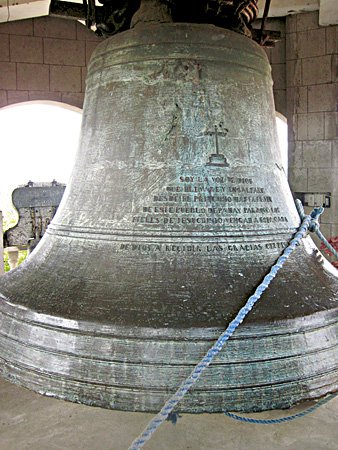Cultural Center of the Philippines
ENCYCLOPEDIA OF
PHILIPPINE ART
[Pan-ay Bell]
1878 / Bronze / Diameter 213.5 cm; height 152.5 cm; weight 10.4 MT / Cast by Juan Reina, under commission from Fr Jose Beloso, OSA / Santa Monica Church, Pan-ay, Capiz
The Pan-ay bell has earned for itself the reputation as the largest bell in Asia and is referred to by the locals as dako nga lingganay or dakung lingganay (big bell). It hangs from the belfry of the Santa Monica Church in Pan-ay, surrounded by eight other smaller bells, cast by different fundidores or bell casters, at different periods. The Pan-ay bell was made in 1878 by Reina (also spelled “Reyna”), under commission from Father Beloso, who served as parish priest of the town from 1844 until his death in 1888. It was cast at the site (Pan-ay) from 70 sacks of coins donated by the local townspeople.
Not much is known about the Pan-ay bell, although there is some lore surrounding its origins. For example, stories circulate that the coins used in manufacturing the bell were of gold and silver, though this is hardly true. The notion may be traced to the custom of throwing gold and silver coins into the molten metal, at which time the priest would bless the bell, lead a procession solemnly around the furnace, and recite a Psalm. It is highly likely that the coins collected from the townspeople were of copper, which is a main element in bronze. Bronze was quite normative for many Philippine bells. There is also a more remarkable account of how the bell was hauled down by Muslim raiders and dumped into the sea, only to be returned to the belfry by some unseen hand. While quite fantastic, it is no different from similar miraculous stories of venerated objects disappearing for one reason or the other, only to reappear mysteriously.
Circumstances relating to the life of Reina, the bell caster, are equally interesting. He is said to have settled in Iloilo city’s J.M. Basa St in 1868 and there established a smith and casting shop. Another source places him in nearby Molo, at Calle Fundicion. Father Beloso was known to have summoned Reina to Capiz to make the Pan-ay bell. It is also told that apart from being a bell caster, Reina was also a dentist. There supposedly occurred a falling out between Reina and Father Beloso over a bell that broke a month after it was cast. The parish priest wanted it recast for free, to which the bell caster could not agree. However, things were eventually resolved as the priest had a horrible toothache that could only be cured by a dentist, who happened to be no other than Reina himself!
The Pan-ay bell carries Reina’s trademark, consisting of a simple cross on a stepped base. This mark is present in the other bells that he made, even though they do not carry his name. Although Reina is known as the bell’s maker, two other names are inscribed together with his on the bell: Benitus a Regibus (Benito de los Reyes) and Hilario Sunico. The addition of the names of the two older master bell casters was a sign of respect on the part of Reina. The bell also bears an inspiring inscription that reads (in translation): “I am God’s voice which shall echo praise from one end of the town of Pan-ay to the other, so that Christ’s faithful followers may enter this house of God to receive heavenly graces.” It is a voice that may be heard from eight kilometers away.
Written by Marilyn R. Canta
Sources
Achanzar, Honey Libertine R. 1992. “The Philippine Kampana: Its Sonic and Non-sonic Meaning.” MA thesis, University of the Philippines
Diliman, Quezon City.
Capiznon.org. 2008. “Pan-ay bell: The Biggest Church Bell in Asia.” 20 Aug. Accessed 11 Jun 2014.
Cojuangco, Tingting. 2009. “For Whom the Bells Toll.” The Philippine Star, 7 Jun.
Ducharme, Fergus. 2014. “The Church of Santa Monica, the First Church on Panay Island; It’s a National Historic Site & Home of the
Biggest Church Bell in Asia.” Historic Old Philippines. Posted 11 Jun.
Javellana, Rene B. 2010. La Casa de Dios: The Legacy of Filipino-Hispanic Churches in the Philippines. Photographs by Betty Lalana and
Lino Arboleda. Pasig City: Ortigas Foundation.
